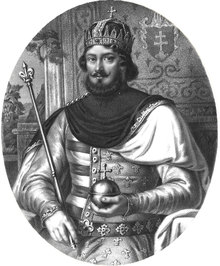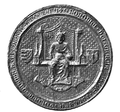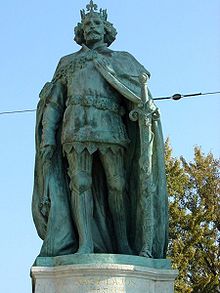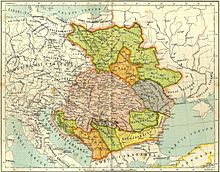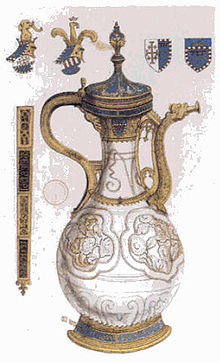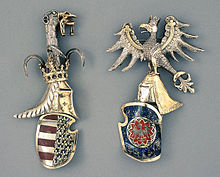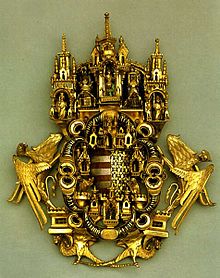- Louis I of Hungary
-
"Lajos Nagy" redirects here. For the footballer, see Lajos Nagy (footballer).
Louis I 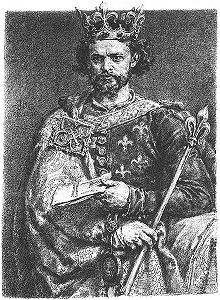
King of Hungary and Croatia Reign 21 July 1342 – 10 September 1382 (40 years, 51 days) Predecessor Charles I Successor Mary King of Poland Reign 17 November 1370 – 10 September 1382
(11 years, 297 days)Predecessor Casimir III Successor Jadwiga Spouse Margaret of Luxembourg
Elizabeth of BosniaIssue Catherine of Hungary
Mary of Hungary
Hedwig of PolandHouse Angevin (Anjou-Hungary) Father Charles I of Hungary Mother Elizabeth of Poland Born 5 March 1326
Visegrád, Kingdom of HungaryDied 10 September 1382 (aged 56)
Nagyszombat, Kingdom of Hungary (present-day Trnava, Slovakia)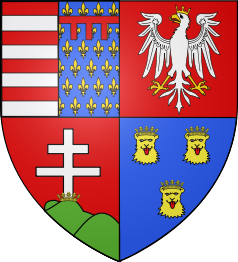 Coat of arms (clockwise from upper left): paternal (Hungary – the Arpad stripes – and Anjou-Sicily), Poland, Dalmatia, and Hungary (the double cross).
Coat of arms (clockwise from upper left): paternal (Hungary – the Arpad stripes – and Anjou-Sicily), Poland, Dalmatia, and Hungary (the double cross).
Louis the Great (Hungarian: I. (Nagy) Lajos, Croatian: Ludovik I, Polish: Ludwik Węgierski, Ukrainian: Людвік I Великий, Slovak: Ľudovít Veľký, Italian: Luigi I d'Ungheria, German: Ludwig der Große, Bulgarian: Лудвиг I, Serbian: Лајош I Анжујски, Czech: Ludvík I. Veliký, Lithuanian: Liudvikas I Vengras (5 March 1326, Visegrád – 10 September 1382, Nagyszombat/Trnava) was King of Hungary and Croatia from 1342 and King of Poland from 1370 until his death.[1][2] (See Titles section)
Louis was the head of the senior branch of the Angevin dynasty. He was one of the most active and accomplished monarchs of the Late Middle Ages, extending territorial control to the Adriatic and securing Dalmatia, with part of Bosnia and Bulgaria, within the Holy Crown of Hungary. During his reign Hungary reached the peak of its political influence.[3]
He spent much of his reign in wars with the Republic of Venice. He was in competition for the throne of Naples, with huge military success and the latter with little lasting political results. Louis is the first European monarch who came into collision with the Ottoman Turks.
He founded the University of Pécs in 1367, the letter patent issued by pope Urban V [4]
Contents
Family
Louis was the third son of Charles I of Hungary and Elisabeth of Poland, the daughter of Ladislaus the Short and sister to Casimir III of Poland.
In 1342, Louis married his first wife, Margaret (1335 – 1349), underaged daughter of Charles IV, Holy Roman Emperor, who died while still a minor. He then married his second wife, Elizabeth, daughter of Stephen II of Bosnia, who became Louis's vassal, and Elizabeth of Kuyavia, in 1353 . Her maternal grandfather was Polish Casimir II of Kuyavia, son of Ziemomysł of Kuyavia and Salome of Eastern Pomerania.
Louis had three known daughters, all born of his second wife:
- Catherine (1370 – 1378)
- Mary, his successor in Hungary, who married Sigismund, at that time Margrave of Brandenburg (1371 – 1395), who became King of Hungary (1387–1437) and Holy Roman Emperor (1433–1437).
- Hedwig, his successor in Poland, who married Jogaila, then Grand Duke of Lithuania
Biography
Louis, named for his great uncle, Saint Louis of Toulouse. Louis acquired the seven liberal arts (grammar, rhetoric, logic, geometry, arithmetic, music, astronomy). When he was sixteen, Louis understood Latin, German and Italian as well as his mother tongue. He owed his excellent education to the care of his mother, a woman of profound political sagacity, who was his chief counsellor in diplomatic affairs during the greater part of his long reign.
In 1342, at the age of sixteen, he succeeded his father as king of Hungary and was crowned at Székesfehérvár on the 21st of July with great enthusiasm. Louis led his armies many times in person. Besides his best known campaigns, he fought in Bulgaria, Bosnia, Wallachia Serbia, Lithuania and against the Golden Horde. The first Ottoman Hungarian clash occurred during his reign.
He led assaults personally and climbed city walls together with his soldiers. He shared the privations and hardships of camp life with his soldiers. Although a few legends were woven around his name, one incident casts light on his courage. When one of his soldiers who had been ordered to explore a ford was carried away by the current, the King plunged into the torrent without hesitation and saved the man from drowning. Louis liked warfare - he came close to losing his life in several battles -, tournaments and hunts. Similarly to his mother he was deeply religious. As an excellent commander and a gallant fighter, Louis resembled his exemplar, King Saint Ladislaus.
Under his reign lived the most famous epic hero of Hungarian literature and warfare, the king's Champion: Nicolas Toldi. John de Cardailhac, patriarch of Alexandria and envoy of the Vatican,(who visited the utmost European countries and monarchs) wrote: "I call God as my witness that I have never seen a monarch more majestic and more powerful... or one who desires peace and calm as much as he."
Economic and legislative activity
Culture of the royal court
Under the reign of his father (Charles I of Hungary), the Renaissance arrived in Hungary. The Renaissance style came directly from Italy during the Quattrocento to Hungary foremost in the Central European region. The development of the early Hungarian-Italian relationships was a reason of this infiltration, which weren't manifested only in dynastic connections, but in cultural, humanistic and commercial relations. This effect was getting stronger from the 14th century. In the first half of the 14th century, the statues of ladies, knights, court musicians, servants and guardsmen mark not only the turn of the 14th and 15th centuries, but also the beginning of a new age. Dressed in full-length gowns, richly gathered cloaks, pointed shoes and daring hats, they are an unexpected reminder of a flourishing, almost decadent Hungarian Trecento, whose mere existence was no more than a conjecture before the miraculous appearance of the archaeological foundings at Buda Castle. At the height of the feudal anarchy, the barons, whose power was far greater than that of the king, fought battles and made alliances. However, by gradually overcoming the power of the barons, breaking the resistance of the renegade towns and putting an end to chaos, Charles I of Hungary, who grew up among the modern financial and trading life of Naples and Milan, brought prosperity to feudal Hungary. Knights, soldiers, businessmen and artists from Naples and other Italian towns brought a new vitality.[5]
Monetary and economic background
Kingdom of Hungary under the Angevins
For the new economic taxation and customs system of his father see the Economic policy of Charles I article.
 Golden Forint, which depict King Saint Ladislaus, who was Louis' idol.
Golden Forint, which depict King Saint Ladislaus, who was Louis' idol.
One of the primary sources of power of his father was the wealth derived from the gold mines of east and northern Hungary. Eventually itself the gold production of mines reached the remarkable figure of 3,000 pounds (1,400 kg) of gold annually - one third of the total production of the world as then known, and five times as much as that of any other European state.[6][7] The gold coin of Hungary (the Forint), of the same weight and purity of its namesake of Florence, was clear proof of the country's prosperity. The Hungarian and Florencian coins were the most valuable coins of the age. The gold flowed in an undiminished stream into Louis' coffers, enabling him to keep a court even more splendid than his father's.
The power of the former Árpád Dynasty was still based on vast royal estates. Under the Angevins, the royal family was restored as the greatest land-owning family of the realm (they had one third of all lands), but the Angevin power was rather based on the possession of castles.
And the whole country, spared for two generations from serious invasion or civil war, blossomed with a material prosperity which it had never before known. By the end of Louis' reign, the total population of Hungary proper had risen to some three million (4 million in complete Hungary, with Croatia, Slavonia and Dalmatia), and it contained 49 royal boroughs, over 500 market towns and more than 26,000 villages. International commerce, favoured by the continued stability and high repute of the currency, began to make headway.
Determinant laws
Hungary
Constitutionally, Louis maintained much of the structure of his father's regime, but introduced several cultural reforms. In 1351 Louis also confirmed the constitution (Golden Bull of 1222), adding an explicit declaration that all nobles enjoyed 'one and the same liberty', a provision which, it appears, besides reaffirming the rights of the noble class as a whole, including the familiares, also enlarged its ranks by bringing full noble privileges to a further class of border-line cases. His other laws introduced the entail system regulating the inheritance of the land-owning class. In 1351, Louis codified the military obligations of the nobility in the so-called Law of Entail (ősiség). In the past the nobility mustered soldiers according to the size of their holdings. With the passage of time, however, many of these estates had been sold or split up, causing diminishing returns and a reduction of military obligations. This was harmful to the country's military strength. Other provisions of the law stabilised land tenure by universalising the system of aviticitas under which all land was entailed in the male line of the owner's family, collaterals succeeding in default of direct heirs; if the line died out completely, the estate reverted to the Crown. The daughters of a deceased noble were entitled to a quarter of the assessed value of his property, but this had to be paid them in cash. [8] This (Law of Entail) is a highly important law, which ensured the integrity of ancestral property, remained in force until 1848 and was to a great extent instrumental in keeping Hungary in Hungarian hands.
At the same time, Louis standardised the obligations of the peasant to his lord at one-ninth of his produce, neither more nor less. As he also had to pay the tithe to the church and the porta to the state, the peasant's obligations were thus not inconsiderable, but do not appear to have been crushing in this age of prosperity; his right of free migration was specifically re-affirmed.[8]
Poland
He decreed that the Polish nobility would no longer be required to pay 'extraordinary' taxes, or pay with their own funds for military expeditions outside Poland. He also promised that during travels of the royal court, the king and the court would pay for all expenses, instead of using facilities of local nobility.
In 1374 King Louis of Hungary approved the Privilege of Koszyce (Polish: "przywilej koszycki" or "ugoda koszycka") in Košice in order to guarantee the Polish throne for Maria and her affianced husband, Count Sigismund of Brandenburg, by locking the gates of the city and allowing none to leave it till they had consented to his wishes. For the female succession of Polish throne, he gave new special rights for Polish nobility. He broadened the definition of who was a member of the nobility and exempted the entire class from all but one tax (łanowy, which was limited to 2 grosze from łan (an old measure of land size)). In addition, the King's right to raise taxes was abolished; no new taxes could be raised without the agreement of the nobility. Henceforth, also, district offices (Polish: "urzędy ziemskie") were reserved exclusively for local nobility, as the Privilege of Koszyce forbade the king to grant official posts and major Polish castles to foreign knights. Finally, this privilege obliged the King to pay indemnities to nobles injured or taken captive during a war outside Polish borders.[9]
Domestic, military and religious policy
Style of government
Despite the Hungarian tradition of the strong parliaments, Louis the Great did not want to share his power with the diet permanently. He convoked the Diet in 1351 and once again in 1352, but never after. The influence of the noblemen extended only to their county. Counties did not have either a permanent armed force nor other authority than the sedria (Latin: county). We cannot even talk about local governments in the counties anymore. To judge local criminals and administration of justice in case of noblemen who could not visit the royal High Court of Justice was the duty of other office bearers - according to the order of the palatine and the king -, who held general meetings for several counties from time to time.
In the 1370s there were several changes in the government, aiming at an even more powerful centralisation of power. The chancellery was divided into two parts, the secret chancellery was established with the lead of the secret chancellor. The head of the former chancellery got the title "supreme chancellor". The third department of the High Court of Justice was set up, too: besides the law court of the palatine and the court of royal presence headed by the supreme judge, the court of special royal presence was formed, headed by the supreme chancellor. The royal treasurer was not a financial office bearer any more, he became the judge of appeal cases of royal towns. His financial duties were taken over by the independent treasure keeper from that time on.[10]
Military structure
During the four decades of his reign, the economic policy and power he inherited from his father was more than enough to carry on his military campaigns. He turned that accumulated economic capital to the uses of power.[11]
The Angevins introduced the so-called honor (=office; in old Hungarian becsü) system. Instead of further large donations (fiefdom/feudum) the faithful magnates (the Baron class and above) of the king were given an office. Powerful officials of the kingdom, like the count palatine, were appointed count (lat. comes, hung. ispán) to several counties. They became the keepers of royal property (including castles) in their counties and the representatives of the king. The barons administered these possessions by their own men (familires, roughly: vassals). Honor ensured real power. While most of the aristocrats had only 2 or 3 castles (even the exceptionally powerful Lackfi family had only 7 castles), the possessions of a greater honor ensured power over 10 or 20 castles. These offices were not given for eternity. The king could deprive the baron of his honor any time. The most powerful honors (residents and governors of his countries) often rotated among the members of magnates. The lesser nobles the "gentry class" invariably got traditional donations: inheritable lands (fiefdom).
The Hungarian military organization was based on the honor system. Every baron, the holders of the great honors, led a banderium (Eng. banner). The banderium was composed of the baronical retinue, the armed noblemen of the baron’s counties, and some peasants from the royal estates who served as light infantry. The banderia ensured a numerous, but mostly inexperienced army. Noblemen were obligated to serve 3 months in defense of the country and 40 days for foreign campaign. On the other hand, the king was powerful enough to neglect this rule if he wished. Besides the banderia, the king could directly raise an army by paying dispositio (salary) to every noblemen who joined him. The king also hired mercenaries for his campaigns. The privileged group of Cumans and Székelys also served the king. Louis set up his artillery in the beginning of his reign, however he used cannons only for city/castle sieges.
Louis often waged wars in two or three frontlines/countries at the same time, and used large foreign mercenary armies in far countries.
Role as champion of the church
Their following campaigns "in every directions" (for example, against the Orthodox Serbs, the heretic Bosnians and pagan Lithuanians and Tartars) are in close connection with the political and converting ambitions of the Holy See. Louis the Great often provided military help in the inner fight of Ecclesiastic State of the Popes. Hungarian troops protected the Pope on his return from Avignon to Rome. In 1356 a letter from the Pope called him "Christ's shield, the Lord's athlete". In the meantime Louis the Great continued his father's policy in banning the collection of papal tithe and asserting royal interest in filling church positions. In 1370, Louis financed the wars of the pope (Urban V) against the Florentines.[12]
During the fight for the throne of Naples there was an intensive exchange of ministers between the Papal and the Hungarian court. After this period Papal legates visited Hungary only on very important occasions. Their duties included converting in the East, settling the Balkan situation, mediating in peace treaties. Bishop Guido's legation in 1349 was a very important one. The Popes recognised the Turkish danger early and in this matter Pope Urban V sent his minister to Buda. In 1371 a papal legate came to Hungary to settle the dispute between King Louis and Emperor Charles IV. At the same time Hungarian legates spent months in Avignon, where - besides settling public matters - they forwarded the requests of their relatives or familiares to the Pope in the form of so-called papal requests (supplicatio).[13]
Wars and campaigns
During his 40 years-long reign, there were only three years of peace (1342, 1375, 1376).
Italian wars
Wars with Venice and Naples
Main articles: Neapolitan campaigns of Louis the Great, Treaty of Zadar, and Peace of Turin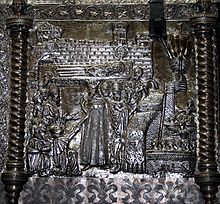 Louis in Zadar. Contemporary embossment.
Louis in Zadar. Contemporary embossment.
In 1345, Louis decided to capture the city of Zadar, on the Dalmatian coast. His soldiers however refused to take the field, since some Hungarian leaders had been corrupted by Venice before the battle.
In the spring of 1346 the Hungarian King arrived with his vast Royal Army of 100,000 men, of whom more than 30,000 were horsemen and men-at-arms and 10,000 were soldiers under Stephen II. The Venetians had attempted to bribe several Hungarian generals, including the Bosnian Ban, who gave away the positions of Hungarian troops. On 1 July 1346 a fierce clash followed, which the Hungarian side eventually won only due to its numerical superiority, leaving some 7,000 casualies on the field.[citation needed] Zadar remained in Venetian hands.
Louis embarked on an expedition against Naples in revenge of the murder of his younger brother Andrew, Duke of Calabria, husband of Joan I of Naples. The circumstances of his death – in a palace conspiracy – suggested the involvement of the Napolitan queen. The news of Prince Andrew's murder created great consternation throughout Europe and especially in Hungary. Since the Pope had failed to bring the guilty to justice, King Louis declared war on Naples and personally led his troops into Italy. Louis entered Italy on 3 November 1347 and, after obtaining the support of many local princes, he entered Benevento early in 1348, much to the applause of the Neapolitan baronage. Louis defeated his enemies in Battle of Capua. Many of the conspirators escaped, but king Louis would capture Charles of Durazzo and ordered his execution. However, he was proved to be innocent, and Louis subsequently lost much of his popularity in Italy. He also did not trust the locals who originally supported Andrew’s cause, and they became hostile to him. On 15 January, Queen Joan fled Naples by ship to Provence, soon to be followed by her second husband, Louis of Taranto. Having established himself in Naples with little difficulty, Louis was nevertheless forced to withdraw quickly by the arrival of the Black Death. In his rush to leave ravaged Italy, he appointed two Hungarian officials to hold the regency. They soon lost the support of the local barons and opened the way for the return of Joan and her husband.
Two years later, early in 1350, King Louis landed at Manfredonia. After serials of successful battles city and castle sieges, he was again able to control the Kingdom of Naples and its capital city. On this Napolitan journey, Louis the Great carried gold coins equal to Hungary's six, and Europe's two years, of total gold production, with countless silver pieces piled atop them.[11] However, the Kingdom of Naples was namely a vassal state of the Papacy, and the Hungarian-Neapolitan union would have harmed papal interest. Louis could not become the legal king of Naples without the assent of Pope Clement VI; therefore he soon called off the campaign at the insistence of his exhausted troops and renounced all claims on the Neapolitan crown. Before leaving Italy, he had the papal curia of Avignon begin an inquest into the murder of Andrew, but the papal court found Joan innocent, largely for political reasons, as Joan agreed to ceded her temporal rights over the city of Avignon to the papacy. The conflict with Naples was finally settled in 1381, one year before Louis’ death. Pope Urban VI stripped the royal title from Joan and authorized king Louis to execute his decision. He was too ill to go personally, but his nephew, Charles of Durazzo, with the help of Hungarian gold and troops, seized the throne and killed Joan, who was smothered with pillows, in revenge for the method of Andrew's assassination.[14])
From 1357 to 1358, Louis waged a new war against Venice for the rule of Dalmatia. After successfully organising an anti-Venetian league, Louis put the cities of Dalmatia to fire and the sword, expelling all the Venetians. By the Treaty of Zara (1358), all of Louis's demands over the Adriatic region were recognized. He immediately built up an Adriatic fleet. After the third Venetian war (1372–1381) Venice had to pay annual tribute to Louis (Peace of Turin, 1381). The Venetians also had to raise the Angevin flag on St. Mark's Square on holy days. In 1381 Louis obtained from the Republic of Venice the relics of St. Paul the Hermit, which were taken with great ecclesiastical pomp to the Pauline monastery near Buda.[15]
Louis' Italian army contained German mercenary heavy infantry and English longbowmen, Hungarian heavy knights and light cavalry from Hungary, Louis party Italians and Italian nobles.
Northern wars
In the North, Louis's diplomacy, moreover, was materially assisted by his lifelong alliance with his uncle, King Casimir III of Poland, who had appointed him his successor. Louis waged successful wars against the pagan Lithuanians, Mongols, and against Bohemians. The young Louis had become very popular in Poland due to these campaigns. In Poland, Louis defeated Lithuanians (1350–1352) and the Mongols(Golden Horde), and conquered Galicia (Central-Eastern Europe). After the serials of victories over the Tatars, the Hungarian sphere of influence stretched eastward as far as the Dniester.[16] In 1345 Bohemians besieged Kraków, the Polish capital. Louis arrived in time and dispelled the Bohemian army. In the wars between 1345–47, Louis defeated the Golden Horde. After uncle Casimir's death in 1370, Louis organised a very lavish Angevin-style funeral for uncle Casimir to demonstrate his power and wealth in Poland. The Poles elected Louis King of Poland in compliance with the agreement made in Visegrád during his father's reign. In accordance with the 1355 dynastic agreement, he was crowned King of Poland at Kraków 17 November 1370 by Iaroslav Archbishop of Gniezno, primate of Poland.[17] Being the ruler of Poland, however, was not an unqualified pleasure. After he became king of Poland Louis ruled the country through regents.
Louis had commissioned (his mother) Elizabeth of Poland as Regent of Poland (1370–1375) to conveniently eliminate her from his Court. Still, Queen Elizabeth had some justification for taking part in the affairs and quarrels of Poland, being a Polish princess. The Poles hated to pay taxes and loved to quarrel among themselves and with the Court, especially with the domineering dowager Elizabeth. Elizabeth's regency turned out to be a failure, her background notwithstanding. In 1375, the Poles killed 160 of her Hungarian bodyguards and the mother Queen escaped to Hungary. Louis reconed with the rebels, and strengthened his power again, at his mother's expense. In 1378, Louis appointed his loyal vassal and friend: prince Władysław of Opole as his regent in Poland.
Balkan and Turkish wars
In 1344 Wallachia and Moldova became Louis's vassal.[18]
Louis with his ernomous 80,000 strong army repelled the Serbian Dušan's armies in vojvodine of Mačva and principality of Travunia in 1349. when Czar Dusan broke into Bosnian territory he was defeated by Bosnian Stjepan II with the assistance of King Louis' troops, and when Dušan made a second attempt he was decisively beaten by his luckier rival, King Louis the Great himself, in 1354.[19] The two monarchs signed the peace agreement in 1355.
His latter campaigns in the Balkans were aimed not so much at conquest and subjugation as at drawing the Serbs, Bosnians, Wallachians and Bulgarians into the fold of the Roman Catholic faith and at forming a united front against the looming Turkish menace. In 1366 the Kingdom of Bosnia recognised the Hungarian authority, but Louis had himself crowned as King of the Serbians and Bosnians. After facing the Hungarian King Louis I in several locations, the last military campaign of the Hungarian monarch was decisive and in 1367 Lazar of Serbia recognised his authority over the Serbians. Louis annexed Moldavia in 1352 and established a vassal principality there, before conquering Vidin in 1365. The spread of Hungarian influence in the future Moldavia also contributed to an increasing Romanian presence in the territory, because the Romanian elements that would organize Moldavia, migrated there from the Kingdom of Hungary, from the region of Maramureş.[20] In the spring of 1365, Louis I headed a campaign against the Bulgarian Tsardom of Vidin and its ruler Ivan Sratsimir. He seized the city of Vidin on 2 May 1365; the region was under direct Hungarian rule until 1369.[21] Louis took Ivan Sratsimir and his family into captivity. Later, in 1369, Louis reinstalled Ivan and the country got vassal status. In 1366 Byzantine Emperor John V visited Hungary to beg for help against Turks. John V came to the Hungarian capital of Buda, where according to one account he acted arrogantly while he was asking for military help. Other accounts dispute this but the rulers parted on bad terms, John V had to leave one of his sons as hostage.[22] It was relatively easy to subdue Balkanian Orthodox countries by arms, but to convert them was a different matter. Despite Louis' efforts, the peoples of the Balkans remained faithful to the Eastern Orthodox Church and their attitude toward Hungary remained ambiguous.
The rulers of Serbia, Bosnia, Walachia, Moldavia, and Bulgaria became his vassals. They regarded powerful Hungary as a potential menace to their national identity. For this reason, Hungary could never regard the Serbs and Wallachians as reliable allies in her subsequent wars against the Turks. The Ottoman Turks confronted the southern vassal states in the Balkan region ever more often. However Louis defeated the Turks when Hungarian and Turkish troops clashed for the first time in history at Nicapoli in 1366. The Hungarian Chapel in the Cathedral at Aachen was built to commemorate this victory. He defeated the Turkish army in Wallachia in 1374.
But it is easily arguable that his Balkan enterprises brought Hungary, on balance, more of a loss than benefit.
Inheritance of Poland and death
 Castle of Diósgyőr in Hungary, which was one of his favourite rural hunting castles
Castle of Diósgyőr in Hungary, which was one of his favourite rural hunting castles
In 1370, the Piasts of Poland died out. The last dynast, Casimir the Great, left only female issue and a grandson. Since arrangements had been made for Louis's succession as early as 1355, he became King of Poland upon his uncle's death in right of his mother, who held much of the practical power until her death in 1380 .
When Louis died in 1382, the Hungarian throne was inherited by his daughter Mary. In Poland, however, the lords of Lesser Poland did not want to continue the personal union with Hungary, nor to accept Mary's fiancé Sigismund as a regent. They therefore chose Mary's younger sister, Hedwig as their new monarch. After two years of negotiations with Louis widow, Elizabeth of Bosnia, who was regent of Hungary, and a civil war in Greater Poland (1383), Hedwig finally came to Kraków and was crowned "King" (not Queen) of Poland on 16 November 1384. The masculine gender in her title was intended to underline the fact that she was a monarch in her own right and not a queen consort.
Peace in Hungary in a turbulent Europe
Although he waged a host of campaigns outside Hungary, Louis did keep peace within Hungary itself. In an era when Spain was harassed by the Arabs, France targeted by the English, Germany tormented by the rivalries of its princes, Italy the scene of bloody conflicts among its city-states, Poland and Russia the objects of Lithuanian and Tartar attacks, and Byzantium and the Balkan states subject to Turkish raids and expansion, Hungary flourished as an island of peace.
In death as in life, Louis expressed his wish to lie eternally by his idol's side. Accordingly, he was laid to rest in Nagyvárad beside the tomb of King Saint Ladislaus.
Ancestors
Ancestors of Louis I of Hungary 16. Charles I of Naples 8. Charles II of Naples 17. Beatrice of Provence 4. Charles Martel of Anjou 18. Stephen V of Hungary 9. Maria of Hungary 19. Elizabeth the Cuman 2. Charles I of Hungary 20. Albert IV, Count of Habsburg 10. Rudolph I of Germany 21. Heilwig of Kiburg 5. Klementia of Habsburg 22. Burckhard V of Hohenburg 11. Gertrude of Hohenburg 23. Mechtild of Tübingen 1. Louis I of Hungary 24. Konrad I of Masovia 12. Casimir I of Kuyavia 25. Agafia of Rus 6. Władysław I the Elbow-high 26. Casimir I of Opole 13. Euphrosyne of Opole 27. Viola 3. Elisabeth of Poland 28. Władysław Odonic 14. Boleslaw the Pious 29. Hedwig 7. Hedwig of Kalisz 30. Béla IV of Hungary 15. Jolenta of Poland 31. Maria Laskarina Titles
King of Hungary, Dalmatia, Croatia, Rama, Serbia, Galicia, Lodomeria, Jerusalem and Sicily from 1342, King of Poland from 1370
References
- ^ Louis I. (2009). In Encyclopædia Britannica. Retrieved 24 April 2009, from Encyclopædia Britannica Online: http://www.britannica.com/EBchecked/topic/348730/Louis-I
- ^ [1][dead link]. Archived 2009-11-01.
- ^ http://encyclopedia.farlex.com/Louis+the+Great
- ^ Homepage of the University of Pécs
- ^ "History of Hungary". Impulzus.sch.bme.hu. http://impulzus.sch.bme.hu/info/hunhist.html. Retrieved 2009-11-16.
- ^ "Hungary - History". Nationsencyclopedia.com. http://www.nationsencyclopedia.com/Europe/Hungary-HISTORY.html. Retrieved 2008-11-21.
- ^ "C. A. Macartney: Hungary - A Short History". Mek.oszk.hu. http://mek.oszk.hu/02000/02086/02086.htm. Retrieved 2008-11-21.
- ^ a b "Macartney". Hungarian-history.hu. http://www.hungarian-history.hu/lib/macartney/macartney05.htm. Retrieved 2009-11-16.
- ^ http://www.almanachdegotha.org/id197.html
- ^ "Knight Kings". Mek.niif.hu. http://mek.niif.hu/01900/01949/html/index1.html. Retrieved 2009-11-16.
- ^ a b http://www.hungarian-history.hu/lib/lazar/zar07.htm
- ^ "Full text of "Studies in church history"". Archive.org. http://www.archive.org/stream/studiesinchurchh02pars/studiesinchurchh02pars_djvu.txt. Retrieved 2009-11-16.
- ^ KNIGHT KINGS, Church History: Connection with the Holy See (György Rácz)
- ^ http://chestofbooks.com/reference/American-Cyclopaedia-6/Joanna.html
- ^ "Printer Friendly - Catholic Online". Catholic.org. http://www.catholic.org/printer_friendly.php?id=5973§ion=Encyclopedia. Retrieved 2009-11-16.
- ^ Vásáry 2005, p. 156.
- ^ "POLAND". Fmg.ac. http://fmg.ac/Projects/MedLands/POLAND.htm. Retrieved 2009-11-16.
- ^ "Hungary Kings". Fmg.ac. http://fmg.ac/Projects/MedLands/HUNGARY.htm#LajosIdied1382B. Retrieved 2009-11-16.
- ^ "Full text of "Austria-Hungary and the war"". Archive.org. http://www.archive.org/stream/austriahungarywa00ludwrich/austriahungarywa00ludwrich_djvu.txt. Retrieved 2009-11-16.
- ^ Vásáry 2005, p. 157.
- ^ Божилов, Иван (1994). "Иван Срацимир, цар във Видин (1352–1353 — 1396)" (in Bulgarian). Фамилията на Асеневци (1186–1460). Генеалогия и просопография. София: Българска академия на науките. pp. 202–203. ISBN 9544302646. OCLC 38087158.
- ^ Keneth Setton, The papacy and the Levant (1984) page 300.URL
Louis I of HungaryCadet branch of the Capetian dynastyBorn: 5 March 1326 Died: 10 September 1382Regnal titles Preceded by
Charles IKing of Hungary
1342 - 1382Succeeded by
MaryPreceded by
Casimir IIIKing of Poland
1370 - 1382Succeeded by
HedwigMonarchs of Hungary - Stephen I (1000–1038)
- Peter (1038–1041; 1044–1046)
- Samuel (1041–1044)
- Andrew I (1046–1060)
- Béla I (1060–1063)
- Solomon (1063–1074)
- Géza I (1074–1077)
- Ladislaus I (1077–1095)
- Coloman (1095–1116)
- Stephen II (1116–1131)
- Béla II (1131–1141)
- Géza II (1141–1162)
- Stephen III (1162–1172)
- Ladislaus II (1162–1163)
- Stephen IV (1163)
- Béla III (1172–1196)
- Emeric (1196–1204)
- Ladislaus III (1204–1205)
- Andrew II (1205–1235)
- Béla IV (1235–1270)
- Stephen V (1270–1272)
- Ladislaus IV (1272–1290)
- Andrew III (1290–1301)
- Ladislaus V (1301-1305)
- Béla V (1305-1308)
- Charles I (1310–1342)
- Louis I (1342–1382)
- Mary (1382–1385; 1386–1395)
- Charles II (1385–1386)
- Sigismund (1387–1437)
- Albert (1437–1439)
- Vladislaus I (1440–1444)
- Ladislaus V (1444–1457)
- Matthias I (1458–1490)
- Vladislaus II (1490–1516)
- Louis II (1516–1526)
- John I (1526–1540)
- John II (1540–1570)
- Ferdinand I (1526–1564)
- Maximilian (1564–1576)
- Rudolph (1576–1608)
- Matthias II (1608–1619)
- Ferdinand II (1619–1637)
- Ferdinand III (1637–1657)
- Ferdinand IV (1647–1654)
- Leopold I (1657–1705)
- Joseph I (1705–1711)
- Charles III (1711–1740)
- Maria Theresa (1740–1780)
- Joseph II (1780–1790)
- Leopold II (1790–1792)
- Francis (1792–1830)
- Ferdinand V (1830–1848)
- Francis Joseph (1848–1916)
- Charles IV (1916–1918)
Categories:- 1326 births
- 1382 deaths
- Hungarian Roman Catholics
- Polish Roman Catholics
- Burials at Székesfehérvár Cathedral
- House of Anjou-Hungary
- Hungarian monarchs
- Hungarian princes
- Polish monarchs
- Recipients of the Golden Rose
- Roman Catholic monarchs
Wikimedia Foundation. 2010.


